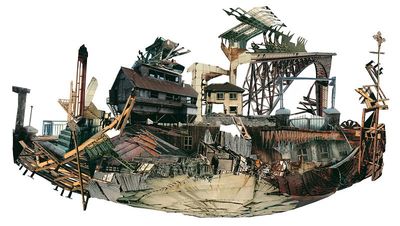
By Lia Snijman
Emma Willemse’s “Archiving loss and longing” was exhibited at the Sasol Art Museum as part of the 2018 Woordfees in Stellenbosch. It chronicles the loss of a home, both physically and emotionally. The choice of a building that belongs to the University of Stellenbosch is somewhat ironic if you look at how many people the university has displaced in order to found and expand the institution, and how many people still feel displaced here.
Initially, my experience of the exhibition is all quite overwhelming: the big cross-shaped table heavy with a display of artist’s books made mainly from wooden parquet floor blocks; the suspended canoe hovering above; the paintings, photos and drawings arrayed on the walls. Even an old wooden cabinet or two, thrown in for good measure. I was uncertain about whether this exhibition would speak to me seeing as I’ve been in the same place – Stellenbosch - for the past 20 years, more or less unmoved even while increasingly restless. But Willemse manages to be nostalgic and melancholic in a way that is movingly felt. As someone from the Western Cape, I was immediately drawn to the painting “After the big storm” that shows a mountain and rain, blending together. You can even see the water splashes. A longer look morphs the mountain into a boat carrying rocks and it makes you wonder what we would end up saving when the big storm to come.
“Bereft” is a stalk with a coagulated but fragmented house as its composite flower. The house is made up of different bits of houses and the compositional arrangement becomes almost dream-like. This image echoes in other works like “Elegy” and “Languish”. The depth perception is spot-on and draws you in, but the sharp edges and incomplete images keep you away and deny complete understanding. The imaginative space of “Bereft” is a lived-experience I am allowed to witness but not fully to understand, like a dream where you try to remember the details but are left with only an inkling of what happened.
I am particularly drawn to Willemse’s trilogy “How to draw”. My accountant side is pleased with the solid idea of structure – some ‘advice’ on how to deal with loss of a home; my literature side is excited by the promise of the book pages.
“How to draw: traces of water” has used the water that seems so destructive in the other works to make papier-mâché art, a possible introspective reference to how Willemse has reconfigured loss into tentative forms of healing. If you look carefully (look carefully), you can see a piece of map which features three rivers. I peer to see if I recognise them but no, Willemse still keeps me at a distance with unfamiliar names. “How to draw: foreground” is once again papier-mâché but with a gashed kloof scored down its middle - beautifully destructive. “How to draw: the last stage” is probably my favourite with the tree made up of ink and bleach and something that looks like tea. Perhaps I am attracted to these pieces because they do not deal directly with the inevitable issue of losing a house which is also a home, something I know I must soon face, as a final year student who has lived her whole life in Stellenbosch. Perhaps, paradoxically, I am attracted to the comfort these artworks hold out to me, of a pragmatic, can-do attitude. I can do this, too. The art of losing.
But when I look at “Grieve” I feel immediate melancholia. Gershwin’s “Rhapsody in Blue” starts playing in my head. It’s then that you realise that Willemse’s art, like music, doesn’t always have to be interpreted and understood. I feel something. I allow it to wash over me like a wave, before I leave.
 SLiPStellenbosch Literary Project
SLiPStellenbosch Literary Project 